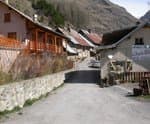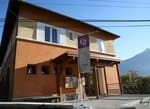Réallon Fort
Arriving at the Fort, what a pleasure it is to come out on to a vast plateau of meadows. The panorama, from Barle summit along to Serre Ponçon lake, is magnificent. The North is dominated by a, summit with steep dry slopes: this is the Roche Méane which reaches an altitude of 2650 m !
9 points of interest
 Flora
FloraOaks and Pines
Oaks and pines live here together. They replace the ancient hay meadows once maintained by the inhabitants of Réallon. The pine forest consists of Black Pines and some Scots Pines. The Austrian Black Pine has long, rigid, prickly dark green needles; those of the Scots Pine are short, twisted and bluish green. Due to its hardiness, The Austrian Black Pine was introduced in the 19th century and was often used to restore the eroded soil of the Southern mountains. This was the case on the « sunny » (Southern slope) at Réallon where it was planted by the Mountain Restoration Service at the beginning of the 20th century to stabilize the slopes and to protect the village and the road.
 Fauna
FaunaRoe Deer
Hidden in the larch forest, the Roe Deer sometimes shows its fine head at dawn or at dusk. Not always easy to see this discreet animal but a few tracks or droppings can give its presence away.: the heart shaped print of its delicate hooves, the trunks of shrubs nicked by young fallow deer rubbing new antlers there to remove the last shreds of velvet, the ground scratched by the young male to mark his territory during the rutting season. Its little round black droppings in piles called « moquettes » in French! Sometimes it is a deep sonorous and guttural bark that resonates in the woods. Have a listen!
 Fauna
FaunaSquirrel
Did you know that the squirrel uses a very elaborate language? It is a sign language, with mimics and expressions, without forgetting the movements of its tail. It also possesses quite an extensive range of sounds. It cackles, yelps, growls or groans, it also chatters. So if you don’t see it come out of the woods, don’t make a sound, maybe you will be lucky enough to hear this animal secretly expressing itself.
 Fauna
FaunaRock Partridge
The Rock Partridge lives in the mountains on well exposed slopes, like those here at Roche Méanne. Every two years, the Ecrins National Park rangers count how many there are on this slope. Before sunrise, they take position in their different « sections » with small tape recorders to imitate the song of these birds. « We listen attentively in case there is an answer ». The song indicates the presence of a « singing male ». « Sometimes we only hear their song, but other times, suddenly, the silence in the mountains is interrupted by the crashing of beating wings which makes us jump. We just have the time to count them and then we see them diving off at top speed ».
 Fauna
FaunaWater Pipit
This little bird in the Passeriforme family can make itself invisible by flying about against the blue of the sky. It is very discreet. Although, it does know how to make itself heard by calling its name : « pi-pit-pipit-pipit-pipit » and all of a sudden, from its highest point of flight, it lets itself glide to the ground, with its wings out like a parachute it makes a jubilatory « piiiiii » sound ! Once it has landed in the meadow grass, it is difficult to see it among the tufts of Festuca.
 Archaeologie
ArchaeologieThe « Clot du Fort » and its canal
With a surface area of approximately 30 ha, the plateau, popularly called the « Clot du Fort », has been used for the cultivation of cereals since Antiquity. At the beginning of the 20th century, a canal measuring around 2,5 km was built from the Pisse torrent to irrigate, via a multitude of secondary canals, 90 privately owned plots. Since these plots having been progressively given over to sheep grazing the canal has fallen in to disuse. It is now reduced to remnants; the path enables you to follow part of the belvedere.
 History
HistoryRéallon Castle
Réallon Castle was no doubt built during the middle of the Hundred Years’ War. Its location enabled it to control different means of access in to the valley thanks to the Champas ravine at the East of the enclosure and to it being partially constructed on a sloped terrain. The castle consisted of a dungeon and a vast enclosure which was used as a refuge to shelter the populations around Réallon in the case of a military attack. This enclosure was confined by a semi-circular tower opened towards the inside. Following the initiative of the community of Réallon, this place known as the « Tour à la Gorge », was completely restored in 2013 with the help of the Ecrins National Park. . Source : Association « Patrimoine en Réallonais ».
 Fauna
FaunaMarmot
Some of them live on the plateau. This is the hikers’ favourite animal. Maybe you will be lucky enough to see it or to hear it whistle. This big rodent is only visible between April and October it takes refuge during the coldest season in its burrow where it hibernates. It lives in a family, respecting a strict hierarchy. Games, grooming, fighting and bighting create the dominance of the couple and the cohesion of the group. Each one participates in installing the boundaries by rubbing their cheeks on rocks and by depositing droppings and urine. When there is danger, the marmot makes a strong shrill whistle in order to warn the others.
 Fauna
FaunaShort toed Snake Eagle
This dry thermophilic slope shelters several reptiles like the Wall Lizard, the Green Lizard, the Aspic Viper or the Grass Snake. The Short toed Snake Eagle essentially eats just reptiles! From the month of March, you will be able to see these large birds flying together in the sky, alternatively swooping and hovering like two silver coloured kites playing in the wind.. Their light coloured stocky silhouettes, their darker coloured heads leave not a shadow of a doubt! The eagles are back.
Description
From the carpark, start by following the Pisse torrent, channeled at the bottom by a dam which protects Réallon village. On the left, look out for the remains of the low dry stones walls which bear witness to ancient agricultural terraces. Then follow to the left taking a bending path that crosses a small forest of oaks and pines.
- Departure : Réallon
- Towns crossed : Réallon
Forecast
Altimetric profile
Recommandations
Each summer season, as in many pastures in the community, flocks of sheep come to graze. Keep your dog on a lead. NB. At the Fort, two reading tables will provide you with more information about the site.
Information desks
Information center "les Gourniers" (summer only)
Les Gourniers, 05160 Réallon
Les Gourniers
05160 Réallon
Tel :
embrunais@ecrins-parcnational.fr
Maison du Parc de l'Embrunais
Place de l’Église, 05380 Châteauroux-les-Alpes
Information, documentation, exhibition, screenings, products and books of the Park. Accessible to people with reduced mobility. Free admission. All animations of the Park are free unless otherwise stated.
Transport
A shuttle service can be reserved at Chorges station to Réallon station (remember to reserve it 36 h in advance on 05 voyageurs or on 04 92 50 25 05).
Access and parking
From Savines-le-lac, to just after the bridge, take the road to Réallon. At the village, just after the wooden bridge, turn right and go up a distance of 200 metres to park in the Coste carpark.
Parking :
Accessibility
More information
Source

Report a problem or an error
If you have found an error on this page or if you have noticed any problems during your hike, please report them to us here:


